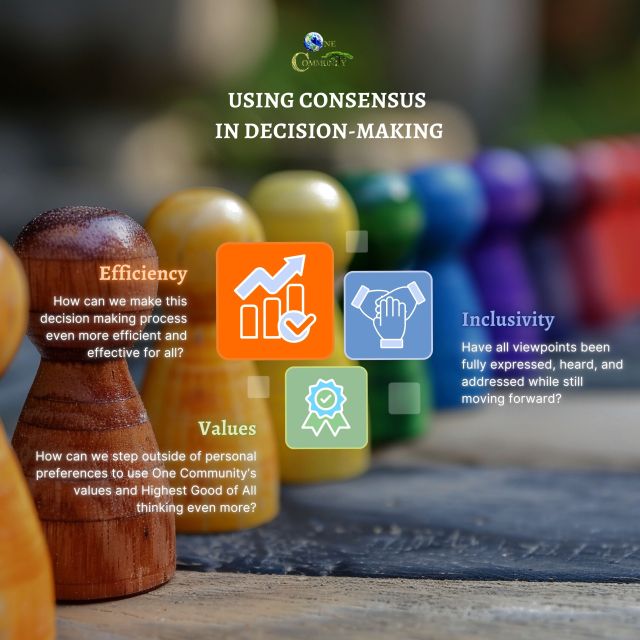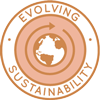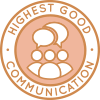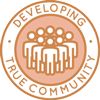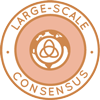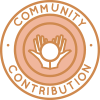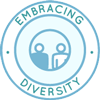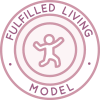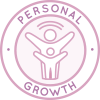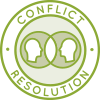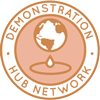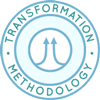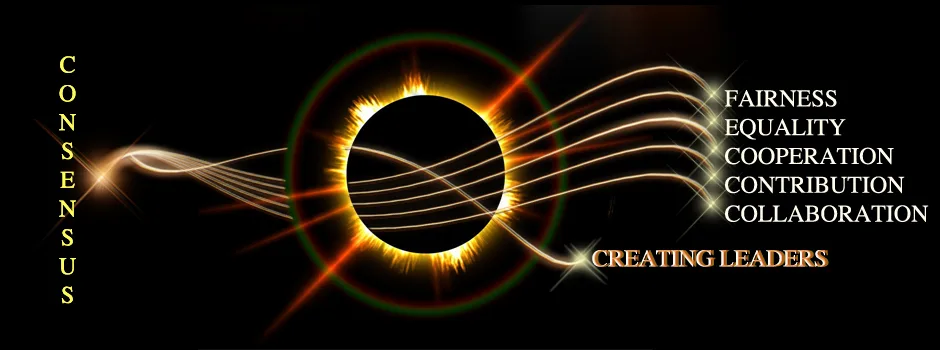
Consensus
Consensus decision-making is a foundational value of One Community because it provides an ironclad guarantee that voices are heard and perspectives are incorporated into implemented actions. Consensus provides the sense of joint ownership that comes from being an active participant in decisions that impact our lives. It is a commitment to equality, communication, and creative solutions with the ultimate end result being a maximally empowered and effective group-creative process. For consensus to work though, it is imperative that the people conducting consensus do so with a consciousness committed to The Highest Good of All, as opposed to the everyone-for-themselves mentality.
This page discusses consensus with the following sections:
- What is Consensus
- Using Consensus in Decision Making
- Why Consensus as a Core Value
- Phasing in Consensus
- Resources
- Summary
- FAQ
WHEN DONE WITH THIS PAGE, WE SUGGEST THESE ALSO
OUR TRAININGS | HOW THIS WILL WORK IN GROUPS OF 200+ | WHERE WE ARE NOW
CLICK THESE ICONS TO JOIN US THROUGH SOCIAL MEDIA
WHAT IS CONSENSUS
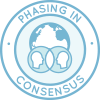 Consensus is a way to synthesize various ideas, perspectives, and concerns into better decisions that everyone can support. Consensus at its core is about creating safety in communication. It is about Loving and realizing our collective oneness. Consensus is about having a consciousness that looks beyond our own perspective and cares for The Highest Good of All. For this reason, it is essential that teams choosing consensus decision making be comprised of people with a consciousness committed to The Highest Good of All, as opposed to the everyone-for-themselves mentality.
Consensus is a way to synthesize various ideas, perspectives, and concerns into better decisions that everyone can support. Consensus at its core is about creating safety in communication. It is about Loving and realizing our collective oneness. Consensus is about having a consciousness that looks beyond our own perspective and cares for The Highest Good of All. For this reason, it is essential that teams choosing consensus decision making be comprised of people with a consciousness committed to The Highest Good of All, as opposed to the everyone-for-themselves mentality.
The founding team of One Community was specifically trained in consensus by One Community consultants Dr. Connie Stomper and Jack Reed (author of The Next Evolution). These consensus trainings are part of the One Community learning and screening process and a requirement for all team members before moving onto the property. Based on experience and training, One Community considers the following especially important to consensus:
- A safe space to voice concerns
- A respectful hearing of all perspectives
- A process by which a group mind emerges from individual input
- An enterprise aimed at achieving The Highest Good of All Concerned
- A way to synthesize various ideas or perspectives into a uniquely new outcome
Likewise, we feel it is valuable for people to clearly understand what consensus isn’t:
- Democracy as we know it
- A method of compromise
- A selection among alternative, competing proposals
- A forum for egotism, manipulation, or “power over”

One Community’s definition of consensus can further be expanded to include these finer and more complex points:
- TWO BASIC KEYS
The two basic keys to the consensus decision-making process are: (1) learning the techniques, and (2) holding the consciousness to work the techniques successfully. Consensus is different from other types of decision-making. It emphasizes the cooperative development of a decision with group members working together rather than competing against each other. The goal of consensus is to create a decision that is consented to by all group members and aligned with The Highest Good Of All Concerned. Having and holding this consciousness is foundational to the success of the consensus model.
- GOING WITH THE SPIRIT OF THE DECISION:
This is the process of making decisions based on the premise that each group member is satisfied with the decision. Not everyone may agree exactly, word for word, but by going with the spirit of the decision, all have agreed on one forward action.
- CONSENSUS IS NO-VOTES UNITY:
In the consensus process there are no votes taken. The goal of unity, which may or may not be born of discord, disagreement, agreement, opposing points of view, attachment/detachment, or other normal expressions occurring in group societies. Consensus decisions are reached with everyone present contributing to the process, united in their intention and the results they want.
- CONSENSUS IS RAISING OUR CONSCIOUSNESS:
Human beings can raise their conscious awareness, their level of acceptance, and their outer expression. This is key to those desiring to reach a consensus. This brings about harmony, unconditional love, joy, and success among societal groups – be it family, group living situations, church, work, or play. The human ability to become refined in our consciousness, allowing for everyone’s mistakes, allowing for everyone’s feelings, thoughts, concerns, and creativity are all part of the consensus model.
- CONSENSUS IS ACCEPTANCE:
The more we allow the spirit of our oneness to flood our consciousness, the closer we come to acceptance. We honor the here and now and differing opinions and perspectives. Acceptance brings in peace and joy. These are symbols that our hearts are open. We begin to share in a greater wisdom than any one of us possess individually such that we can make decisions that work for everyone. In consensus, we must deal with how others think and feel and allow for and incorporate that. More than just acceptance, this requires understanding of self and others.
- CONSENSUS IS COOPERATION:
Everyone’s cooperation is sot during consensus for all decisions made. This leads to higher quality decisions and nobody loses. This is very different from majority rule, where cooperation is expected by those expressing disagreement when they “lose” the vote.
- CONSENSUS IS INTIMACY:
The richness of social consensus comes in part from the intimacy collaborators are willing to cultivate with each other. True intimacy embraces loving, caring, and sharing in a demonstrable, tangible way. Active listening and willingness to share are important components. We’ve found that often group cohesiveness depends a great deal on whether it has developed and acknowledged intimacy and safety. Making decisions that work for all of us requires that we really get to know each other – how we think and feel, what our values are, etc.
- CONSENSUS IS MEETING SKILLS:
In working consensus with a group of people, it is not only necessary to acquire and demonstrate the attitudes and qualities necessary for consensus, but also to have the skills to facilitate successful and productive meetings.
- CONSENSUS IS CREATIVITY:
Consensus invites and includes all those who want to participate. Everyone shares their points of view. Consensus is more than just agreement. We use creativity to expand our consciousness to include even the unrepresented points of view, the unpopular points of view, and the different or least likely points of view. In this way we open ourselves to create the highest quality decision.
- CONSENSUS IS ACCESSING POSITIVE ATTITUDES:
Let’s change our traditional attitudes to the attitude that we can make it work for everyone. We can all win. Consensus means considering what actions would be for The Highest Good of All, along with how each of us can move beyond our own mental or emotional reactions or positions.
- CONSENSUS IS LISTENING:
Effectively operating a consensus model means we listen carefully and with empathy to others even when we disagree with them.
- CONSENSUS IS SAFETY:
Creating a safe space to communicate is essential for consensus to take place. We need to have safety to fully participate, and full participation creates safety. Inner safety addresses our willingness to look at our patterns, concerns, feelings, fears, etc., make them known to ourselves, and be willing to work with them in a constructive and loving way. This may include our willingness to share our history and our personal situations.
- CONSENSUS IS RAPPORT:
Learning how to give and receive feedback in loving neutrality, and in the spirit of learning, is also foundational to the consensus process.
- USING CONSENSUS IN DECISION MAKING*
We ask ourselves these three key questions to apply the core value of “Consensus” when making decisions:
* To ensure we are always aligned with our Purpose, Mission, Vision, and Values, One Community uses the values as defined by our organization as the compass for all our decision making. We then factor in the diversity of individual perspectives and experiences. We highly recommend this approach because it saves us hundreds, if not thousands, of hours of collaborative decision making time. If you are considering our model as a template for your own creation, we especially recommend you apply this approach and use, adapt, or completely change the values we’ve presented so you too can create a clear guidance system that aligns with your own organizational/group/individual needs.
HOW THE GROUP CURRENTLY USES CONSENSUS IN DECISION MAKING
One Community’s Path to Consensus page discusses how we are organizing and making decisions now. The questions above and our current approach are being used as we continue to hone our skills as a group so that every individual fully understands and is able to apply and embody all of the following essential foundations required for consensus decision making*:
- Specific training and screening
- Skillful facilitation and “vibes-watching”
- Everyone wishing to speak gets a chance to do so
- Close-knit, like-minded group with a clear common purpose, vision, and values
- Everyone truly listens to those speaking (rather than rehearsing a rebuttal)
- The facilitator (or someone else) recognizes emerging synergy of ideas
- That each participant discerns whether the consensus is in the best interest of the group
- That the group works together addressing concerns and considerations in crafting a decision that is for The Highest Good of All Concerned
- Everyone does not need to be involved in every decision. The group can decide to allocate decision making to specific people or groups of people
- The following are grounds for stopping or putting on hold a proposal: (1) someone believes that it violates the foundational values of the group, (2) someone believes that more information may be needed, or (3) someone intuitively knows that a higher quality decision awaits. That being said, consensus requires participants to have a maturity of consciousness that prevents running hidden agendas to sidetrack the group from making decisions
- Another group consensus can overturn or alter any prior decisions
In addition to the key components above, all participants are asked “are you complete?” before a consensus decision is made. This assures that participants have no further input and need no further discussion. The consensus decision is made when everyone is complete.
OUR TRAININGS | HOW THIS WILL WORK IN GROUPS OF 200+ | WHERE WE ARE NOW

WHY CONSENSUS AS A CORE VALUE
 We believe consensus is an essential part of the community maintenance process, a foundation for a sustainable society, a key part of what we desire to share as part of our open source blueprint, and a commitment like no other to Oneness and working together for The Highest Good of All concerned. For this reason we are committed to a 100% consensus trained team and phasing in consensus on the property over the first 90 days as outlined below.
We believe consensus is an essential part of the community maintenance process, a foundation for a sustainable society, a key part of what we desire to share as part of our open source blueprint, and a commitment like no other to Oneness and working together for The Highest Good of All concerned. For this reason we are committed to a 100% consensus trained team and phasing in consensus on the property over the first 90 days as outlined below.
PHASING IN CONSENSUS
We will test a mini version of the consensus with large groups model with the first 20 people on the property. The goal is to work our way up from 70% majority consensus to 90% or more during the first 2-3 months. Increases will be made when sufficient consensus (starting with 70%+) agree we are ready. Once we have 50 or more people on the property, we will apply what we learned from our implementation with 20 people. The process will restart and the three-month process outlined below will be used to get to full consensus:
- 1st 45 days: 70% majority consensus to make decisions (35 of 50 must agree)
- 2nd 45 days: 85% majority consensus to make decisions (43 of 50 must agree)
- Full consensus* from the 90-day mark forward with participation optional
This timeline is alterable through the consensus process outlined above. If full-consensus is not achieved by the 90-day target, all members must be present (no more optional participation) until full-consensus (as outlined in the model for consensus for large groups) is adopted. This is for added motivations to achieve full-consensus sooner rather than later. Participation is 100% optional once full-consensus is adopted.
* Note: Read the Frequently Answered Questions section for questions about what decisions will be made by consensus, emergency decision making measures, and more.
RESOURCES
“Consensus is like a symphony. Individual instruments express their differences, but, in working together for The Highest Good, those instruments can create so much more.”
Jack Reed – The Community Planet Foundation
- Our Consensus Partners: The Community Planet Foundation
- Article: “The Basics of Consensus”
- Article: “Consent versus Consensus”
- An excellent structure called “En’owkin” for exploration as part of consensus
- ZEGG Forum – An Authenticity Process | Article
- An interesting article that includes something called the “Advice Process”
- A great resource on Decentralized Autonomous Organizational Protocols, Systems and Technologies
- Gaianet Self-Organization Tutorials (4-part video training)
- Excellent and relevant podcast interviews of Diana Leafe Christian by Paul Wheaton. Diana is an intentional community expert and world renowned authority on consensus. Paul is an expert at running massive online forums and not a fan of consensus.
- CONFLICT RESOLUTION RESOURCES
- Use this page (click here) if you have a resource you’d like to suggest be added here
Here’s a video that introduces another collaborative governance system called Sociocracy. It is similar to our structure and a system we recommend reviewing:
One Community has a Consensus and Decision Making Lesson Plan as part of the open source Highest Good Education component. This lesson plan teaches all subjects, to any learning level, and in any environment using the central theme of “Consensus”. Here is the mind map for the lesson plan:
SUMMARY
 One Community considers consensus decision making a foundation of what we will be open source sharing as a self-governance option for those interested in this component of Highest Good society and creating and living for The Highest Good of All. Through specific training and screening, and a commitment to the consensus process itself, we are growing our team capable of this level of shared responsibility, collaborative trust, mutual empowerment, and “We” versus “I” consciousness embodying teamwork, cooperation, and the true definition of Community.
One Community considers consensus decision making a foundation of what we will be open source sharing as a self-governance option for those interested in this component of Highest Good society and creating and living for The Highest Good of All. Through specific training and screening, and a commitment to the consensus process itself, we are growing our team capable of this level of shared responsibility, collaborative trust, mutual empowerment, and “We” versus “I” consciousness embodying teamwork, cooperation, and the true definition of Community.
FREQUENTLY ANSWERED QUESTIONS
Q: Where can I learn more about your other values and how you use each of them in your organization?
The icons below take you to the complete page of each value:
Q: Where can I get more information about your philosophies for world change?
Please take a look at each of these additional pages: (click icons)
Q: Will consensus be used for every decision?
No, the consensus process outlined on the consensus for large groups page and above will be used to identify which decisions should be made by consensus and which decisions are better made by groups or individuals. These groups or individuals will be consensus-chosen and based on objective qualifications for their role.
Q: How will this process work with groups larger than your initial 50? How does everyone get an equal voice as the number of community members grows?
Please see the Consensus for Groups of 200+ page for complete details on this.
Q: What about disputes and other decision situations where dramatic emotions may become involved?
This is one of the reasons why consensus training and screening are essential. Addressing situations like this is covered in the “Checks and Balances” section of the Large-scale Consensus page under “Consensus Governance Dispute Resolution Format”. Additional details on Conflict Resolution may be found here.
Q: What happens when a decision needs to be made and it is clear just one or two people are determined to block the decision?
Full-consensus decision making, once achieved, will come with a two-step emergency procedure. Step 1 of this process will be the option for any individual to call for an 80% majority consensus to end discussion if it seems all points have been heard, all options explored, and complete inflexibility exists in a small enough minority that an 80% majority consensus can be achieved. If an 80% majority consensus is achieved, then a second 80% consensus can be used to actually make a decision. If both of these 80% consensus decisions succeed, action will be taken in accordance with the will of the 80% majority.
This system eliminates the possibility of any obstructionist individual(s) from coming to a consensus on a decision while also assuring we maintain our commitment to the values of consensus described on this page. It does this because the first 80% consensus requires that at least 80% of those involved in the decision are in agreement that all ideas have been heard, all options have been explored, and ending further discussion is an agreed upon good idea. The second 80% consensus is then still required to see if enough agreement exists to actually make the decision. If either of these 80% consensus fails, discussion continues as needed or the decision is tabled for later discussion.
This emergency process can also be used to keep things moving by moving for agreement on part of a decision, to elect a committee to make the decision, to elect to do more research, etc.
Q: How is the 80% consensus procedure ‘consensus’ if it isn’t 100% agreement, doesn’t ‘consensus’ by definition require unanimous support?
It is still considered consensus because it is a part of the process all participants have agreed upon before joining One Community. It is in place and agreed upon ahead of time to keep us moving towards our overarching goals that go beyond self. In practice, we seek as a group and individuals to first look within to resolve and understand any deviations from living and creating for The Highest Good of All. In the event a few of us forgets this, we’ve agreed to allow 80% consensus that may take a decision in a different direction than we as individuals desire. This serves as a reminder that we are part of a family and Community that we trust. A Community that is equally dedicated to the Highest Good and, in this instance, actually knows what is better within the context of The Highest Good of All.
In short, with the full consensus of the group, consensus can be used to define improvements to itself. In this way, consensus is flexible and group structures like this can be made to hold each other accountable to the common good and what is best for the group process itself.
Q: How does the 80% emergency consensus fit in with ‘No-Votes Unity’, isn’t that just an ‘80% vote to overrule’?
The two-time 80%-consensus process assures we do not exclude the input and opinions of the minority, which is typical with traditional voting. We only move forward with the 80% agreement of the group after specifically checking in that “all points have been heard, all options explored.” The only reason we move forward from there is if 80% agree “complete inflexibility exists in a small enough minority.” This assures that we are maintaining our consensus values and commitment to always flow towards a goal that is greater than the sum of its parts because it includes all perspectives and is aligned towards the Highest Good of All.
Q: After the 90-day point, why must all members be present until full-consensus is achieved?
This is insurance that we achieve full consensus sooner rather than later. It should happen naturally, but anytime before we achieve full consensus an 85% majority could conceivably use consensus to prolong or change the percentage needed to pass things. If the team chooses to change the planned phase-in process, all team members must participate in the consensus process until full consensus is achieved. Everyone participating this way will assure everyone is involved in the process of resolving whatever issues are limiting our ability to implement full consensus.
Q: Are you opposed to voting?
Definitely not. American democracy was built on voting and consensus can be used to choose voting on a decision in situations where further discussion wouldn’t be beneficial. For example, “Are we in consensus that we can just take a vote on this?” If consensus agrees, a vote is taken and the decision is made based on that vote.
 One Community
One Community
